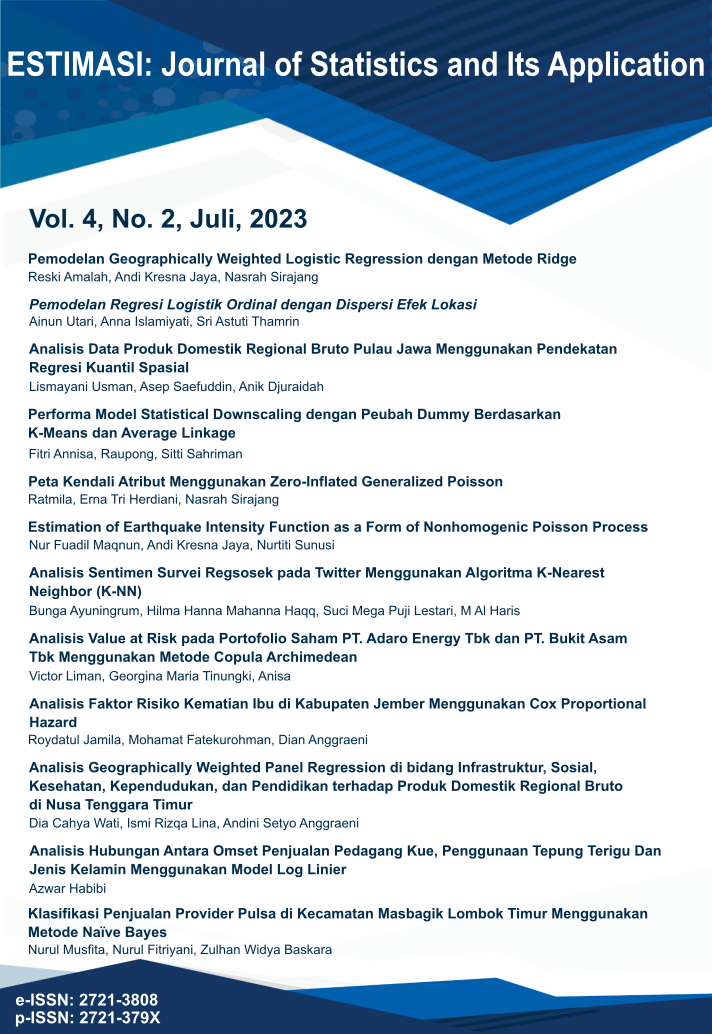Analisis Geographically Weighted Panel Regression di bidang Infrastruktur, Sosial, Kesehatan, Kependudukan, dan Pendidikan terhadap Produk Domestik Regional Bruto di Nusa Tenggara Timur
DOI:
https://doi.org/10.20956/ejsa.v4i2.26718Keywords:
PDRB, GWPR, Adaptive Bisquare, Coefficient of DeterminationAbstract
Gross Regional Domestic Product (GRDP) is an important indicator of economic growth in a region. The success of regional economic growth is said to be good if the GRDP in an area has a significant effect on that area. However, economic growth in East Nusa Tenggara (NTT) has not been optimal. This is caused by economic inequality in NTT which differs between districts/cities. Therefore, the aim of this research is to find out what factors influence GRDP in NTT using Geographically Weighted Panel Regression (GWPR). The data used is sourced from the Central Statistics Agency (BPS) website. The results of the study describe that GRDP in NTT is divided into 12 groups with the adaptive bisquare kernel function and the coefficient of determination is 83.73%. The independent factors that influence GRDP in NTT are the Construction Expensive Index (IKK) and Area Area (LW) in the construction sector, the Human Development Index (IPM) in the Social sector, the Number of Poor population in the population sector, and the Literacy Rate (AMH) in the education sector. Meanwhile, the health sector did not affect GRDP in NTT.
References
Chotimah, C. Modelling of Income Inequality in East Java Using Geographically Weighted Panel Regression. Materials Science and Engineering, 546(5), 2019.
Lin, C. H., & Wen, T. H. Using geographically weighted regression (GWR) to explore spatial varying relationships of immature mosquitoes and human densities with the incidence of dengue. International journal of environmental research and public health, 8(7):2798-2815, 2011
Bruna, F., & Yu, D. Geographically weighted panel regression and development accounting for European Regions. In Proceedings of the 6th seminar Jean Paelinck in Spatial Econometrics, 1-20, 2016.
Ningtyas, D. S. Pemodelan Geographically Weighted Regression (GWR) dengan fungsi pembobot adaptive gaussian kernel, adaptive bisquare kernel dan adaptive tricube kernel, 2019.
Herlina., Indah, M. N., & Arum, P. R. Pemodelan Geographically Weighted Regression Dengan Pembobot Adaptive Gaussian Kernel Dan Adaptive Bisquare Kernel. Thesis Universitas Brawijaya, 2019.
Alfiansyah, H., & Budyanra, B. Analisis Ketimpangan Pembangunan Antar Kabupaten/Kota di Provinsi Nusa Tenggara Timur Tahun 2013-2017. Seminar Nasional Official Statistics, 2019(1), pp. 424-429, 2019.
Peraturan Presiden (PERPRES) tentang Penetapan Daerah Tertinggal Tahun 2020-2024. 2020.
Syaifullah, D. R., & Sari, D. M. Dekomposisi Ketimpangan Pendapatan Dan Determinan Posisi Ekonomi. Jurnal Litbang Sukowati: Media Penelitian Dan Pengembangan, 5(1):125-140, 2021.
Aldona, Y., Primandhana, W. P., & Wahed, M. Analisis Pengaruh Infrastruktur Listrik, Jalan Dan Kesehatan Terhadap Produk Domestik Regional Bruto Di Kabupaten Sidoarjo. Eksis: Jurnal Ilmiah Ekonomi dan Bisnis, 12(1):54-61, 2021.
Mongdong, C. M., Masinambow, V. A., & Tumangkeng, S. Analisis Pengaruh PDRB, Jumlah Penduduk dan Infrastruktur terhadap Penerimaan Pajak Daerah di Kota Tomohon. Jurnal Berkala Ilmiah Efisiensi, 18(5), 2018.
BPS. Produk Domestik Regional Bruto Atas Dasar Konstan 2010 Provinsi Nusa Tenggara Timur Berbagai Tahun Terbitan. BPS Nusa Tenggara Timur. 2020.
Ridha, M. R., & Parwanto, N. B. The effect of foreign direct investment, human development and macroeconomic condition on economic growth: Evidence from Indonesia. Journal of Indonesian Applied Economics, 8(2):46-54, 2020.
saraswat, S. W. Pengaruh Tingkat Pendidikan dan Kesehatan terhadap PDRB Per Kapita di Kota Surabaya. Jurnal Pendidikan Ekonomi (JUPE), 2(3), 2014.
Henukh, C., & Atti, A. Metode Regresi Data Panel untuk Pemodelan Indeks Pembangunan Manusia (IPM) di Provinsi Nusa Tenggara Timur. Jurnal Diferensial, 4(2):103-113, 2022.
Jaya, I. G. N. M., & Sunengsih, N. Kajian analisis regresi dengan data panel. In Prosiding Seminar Nasional Penelitian. Universitas Negeri Yogyakarta, Yogyakarta. 2009.
Pierre De Bellfon, Marrie. Geographically Weighted Regression. file:///C:/Users/user/Downloads/imet131-m-chapitre-9.pdf. Diakses tanggal 8 Oktober 2019. (Hal. 232-254).
Sutikno, S., Otok, B. W., & Lumaela, A. K. Pemodelan Chemical Oxygen Demand (Cod) Sungai Di Surabaya Dengan Metode Mixed Geographically Weighted Regression. Jurnal Sains dan Seni ITS, 2(1), 2013.
Prasetyo, D. A., Sumantri, B., & Masjkur, M. Pemodelan data kesehatan kabupaten banyuwangi dengan regresi terboboti geografis. Xplore: Journal of Statistics, 1(1), 2013.
Laporan Perekonomian Provinsi Nusa Tenggara Timur. Provinsi Nusa Tenggara Timur. 2021
Rosadi, D. Analisis Ekonometrika & Runtun Waktu Terapan dengan R. Yogyakarta:Andi. 2010.
Isnanto, A. Pengaruh PDRB, Kriminalitas, dan Kesehatan terhadap Pajak Penghasilan di Provinsi Jawa Tengah 2015-2019. Universitas Jenderal Soedirman Purwokerto. 2022. Diambil dari http://repository.unsoed.ac.id/15691/.
Downloads
Published
Issue
Section
License
Copyright
It is the author's responsibility to ensure that his or her submitted work does not infringe any existing copyright. Authors should obtain permission to reproduce or adapt copyrighted material and provide evidence of approval upon submitting the final version of a manuscript.


